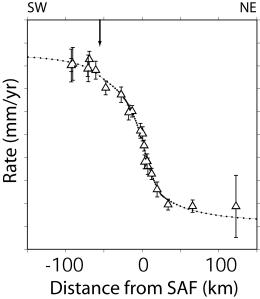 |
GPS data compared to best fit finite element model, assuming different elastic properties in the upper crust on each side of the fault. Model accounts for strike-slip movement on the Carrizo segment of the SAF (located at 0 km on the horizontal axis) as well as the Los Alamos Fault (at -59 km). The model is consistent with geologic, laboratory, paleoseismic, seismic and magnetotelluric data and is also the minimum misfit solution for the GPS data (chi2 = 9.30, reduced_chi2 = 0.58). [Schmalze et al 2006] |